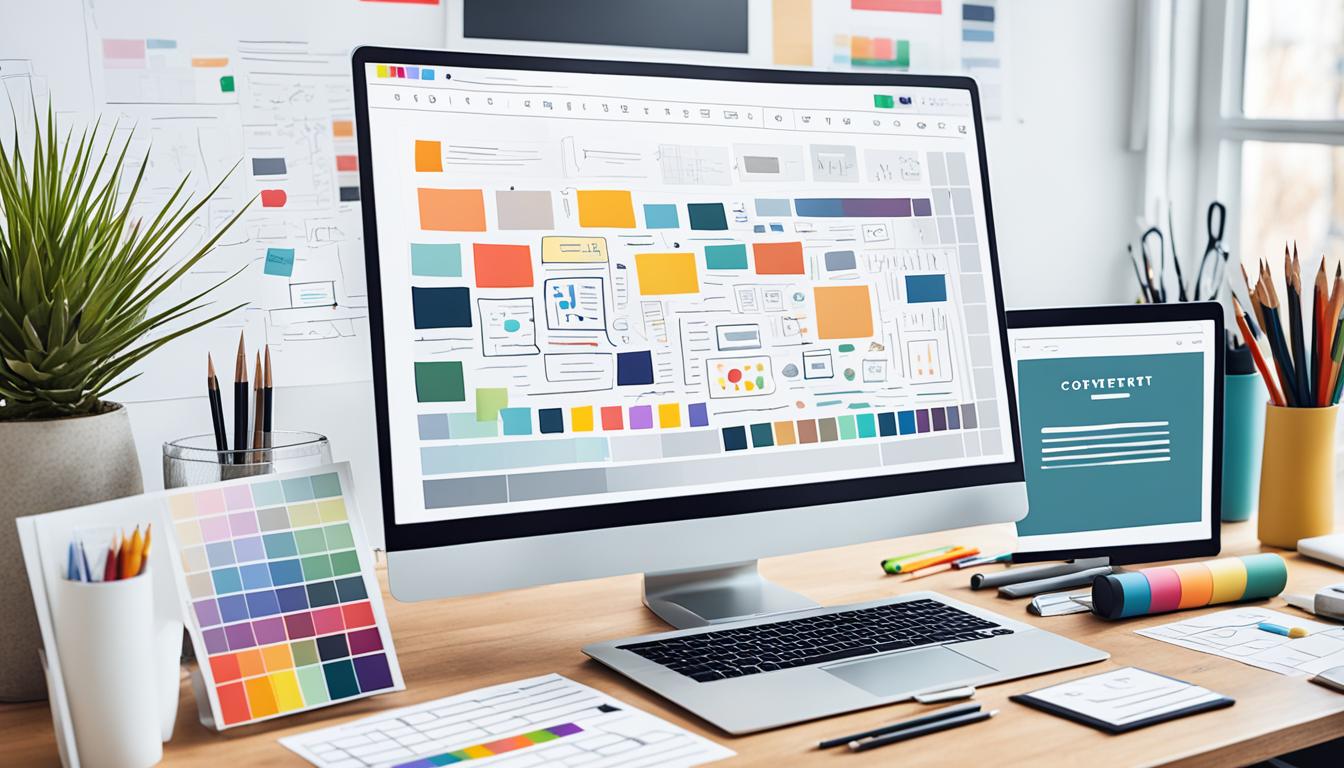10 effective web design principles every designer should know
When it comes to web design, following best practices can have a significant impact on the success of a website. A visually appealing and user-friendly design can attract and engage visitors, while a poorly designed website can drive them away. It’s crucial for designers to understand and implement effective web design principles to create captivating and functional websites.
Key Takeaways:
- Web design principles are crucial for creating visually appealing and user-friendly websites.
- Having a clear purpose for the website helps guide the design and content creation process.
- Quality content and proper use of visuals are essential in web design.
- Layout harmony and typography choices contribute to a seamless user experience.
- Organizing content and using the right colors set the overall tone of the website.
Purpose Sets the Foundation
When it comes to web design, one of the key principles is to have a clear purpose for the website. The website’s purpose acts as a foundation for the design and content creation process, guiding the messaging and calls to action.
Before diving into the design and development stages, it is crucial to define the website’s mission statement and goals. Is the website aimed at promoting purchases, telling the company’s story, or providing educational tutorials? Having a clear understanding of the website’s purpose helps ensure that the design elements and content align with its intended objectives.
Furthermore, understanding the target audience is essential in creating a website that provides the necessary information and value. By identifying the specific needs and pain points of the target audience, designers can tailor the website’s messaging and user experience to address those concerns effectively.
By setting a clear purpose and keeping the target audience in mind, web designers can create websites that not only look visually appealing but also serve their intended purpose in providing valuable content and achieving desired outcomes.
Example of a Website Purpose:
| Purpose | Mission Statement | Target Audience |
|---|---|---|
| Promoting Sales | Our mission is to provide high-quality products that meet the diverse needs of our customers. | Online shoppers looking for reliable and innovative products in the beauty industry. |
| Telling a Company’s Story | We aim to share our journey, values, and commitment to sustainability with our audience. | Environmentally conscious individuals interested in supporting eco-friendly brands. |
| Providing Tutorials | Our goal is to empower our community by offering step-by-step tutorials for various DIY projects. | DIY enthusiasts seeking practical guidance and inspiration for their projects. |
Content Gives Meaning
When it comes to web design, one of the most important aspects is creating quality content that gives meaning to the website and engages the audience. Quality content goes beyond just text; it encompasses images, videos, and other media that add value and relevance to the user experience.
A content-first approach is essential in web design. By working with real content from the beginning, designers can ensure that the design complements and enhances the content, rather than the other way around. This approach allows for a more seamless integration of design elements and easy identification of necessary changes throughout the process.
Creating SEO-friendly content is another critical factor in web design. When developing content, it’s important to consider relevant keywords and phrases that align with the website’s purpose and target audience. Integrating these keywords in a conversational tone helps improve search engine visibility, driving organic traffic to the website.
By prioritizing quality content and adopting a content-first approach, web designers can create websites that not only look visually appealing but also provide valuable information and guide users towards their desired actions.

The Benefits of a Content-First Approach:
- Ensures a seamless integration of design and content.
- Allows for easy identification of necessary changes throughout the design process.
- Enhances the overall user experience by prioritizing valuable information.
- Improves search engine visibility and drives organic traffic to the website.
Key Points to Consider for SEO-Friendly Content:
- Research and incorporate relevant keywords and phrases in a natural, conversational tone.
- Provide valuable and informative content that meets the needs of the target audience.
- Optimize headings, meta tags, and image alt attributes for better search engine visibility.
- Create engaging and shareable content to attract inbound links and social media mentions.
| Content-First Approach | Benefits | |
|---|---|---|
| 1 | Prioritize working with real content from the beginning. | – Seamless integration of design and content. – Easy identification of necessary changes throughout the process. |
| 2 | Create SEO-friendly content by incorporating relevant keywords. | – Improved search engine visibility. – Increased organic traffic to the website. |
| 3 | Ensure valuable and informative content that guides users towards desired actions. | – Enhanced user experience. – Greater engagement and conversions. |
Visuals Keep People Engaged
Visual elements are a vital component of web design as they not only enhance the aesthetic appeal of a website but also reflect and communicate the brand’s visual identity. The use of high-quality visuals, such as photos, illustrations, and graphics, can captivate users and make the website more engaging.
When incorporating visuals into web design, it’s important to strike a balance between text and graphics. Visual elements should complement the written content and help convey the message clearly. By using exciting hero images, animated transitions, and scroll-triggered effects, designers can enhance the user experience and make the navigation more interactive and enjoyable.
High-quality visuals are key to creating an engaging web experience. They not only capture the attention of users but also communicate the brand’s identity effectively. It’s essential to use visuals that align with the brand’s visual identity to maintain consistency throughout the design.
Whether it’s showcasing products, illustrating concepts, or creating a compelling visual story, incorporating high-quality visuals into web design can leave a lasting impression on users and keep them engaged.
| Benefits of Visuals in Web Design | Examples |
|---|---|
| Enhances user experience |
|
| Reflects and communicates the brand’s visual identity |
|
| Makes the website more engaging |
|
Harmony Makes a Design Sing
A well-designed layout brings together various elements to create a harmonious user experience. From HTML and CSS to fonts, visuals, and navigation, every component plays a crucial role in achieving layout harmony. By ensuring that all these elements work seamlessly together, designers can create user-friendly designs that captivate and engage users.
A key aspect of achieving layout harmony is maintaining brand consistency. A design should reflect the brand’s identity, values, and aesthetics. Consistent use of colors, typography, and visual elements across the website helps to establish a strong brand presence and enhances user recognition and loyalty.
When it comes to user-friendly design, eliminating incongruities and elements that feel out of place is crucial. These inconsistencies can be distracting and disrupt the user’s journey, leading to a subpar experience. Skilled designers have an eye for detail and ensure that every aspect of the design aligns with each other and creates a cohesive whole.
Brand guidelines and living style guides are essential tools for maintaining consistency throughout the design process. They provide designers with a clear framework to follow, ensuring that every design decision aligns with the brand’s values and objectives. By adhering to these guidelines, designers can achieve a harmonious and consistent design that truly represents the brand.
Overall, layout harmony is essential for creating a visually appealing design that is user-friendly and aligned with the brand’s identity. By paying attention to detail, maintaining brand consistency, and following design principles, designers can create designs that not only look good but also deliver a seamless and enjoyable user experience.

Typography Shapes Perception
When it comes to web design, typography is a powerful tool that can shape user perception and enhance the overall experience. The choice of fonts plays a crucial role in determining the look and feel of a website.
When selecting fonts, it’s important to consider their suitability to the design and the desired tone of the website. For headings or decorative purposes, cursive typefaces may work well, adding flair and personality to the design. However, for large blocks of text, practicality and readability become essential factors to consider.
The right font can enhance the content, making it more engaging and easier to read. On the other hand, the wrong font can undermine the message and make the text difficult to comprehend. It’s essential to strike a balance between traditional and stylized typography, ensuring both readability and a touch of personality.
Readable text is key to keeping users on your website. When the text is legible and easy to read, visitors are more likely to stay and engage with the content. Therefore, it’s crucial to choose fonts that are easy on the eyes and ensure a smooth reading experience.
By carefully considering font selection and typography choices, designers can create a visually appealing and readable text that enhances the overall design of the website.
Organization Unifies
When it comes to designing a website, a well-organized structure is key to creating a seamless user experience. The content should have a logical flow and a hierarchical structure that guides the audience towards a clear conclusion. Each piece of content should build upon the previous one, ensuring that visitors can easily navigate and understand the information presented.
One effective way to structure web content is by using header tags. These tags not only help with search engine optimization but also provide a visual organization of the content. By using headings and subheadings, you can break down the information into digestible sections, making it easier for users to scan and locate the specific details they are looking for. This also enhances the readability of the content, ensuring that important points stand out and capture the reader’s attention.
Visual organization is equally important in web design. Images and graphics should be strategically placed to complement the written content and engage users. Visual elements can help break up large blocks of text, making the information more visually appealing and easier to consume. When choosing images, consider their relevance to the topic and ensure they align with the overall design aesthetic of the website.
To further enhance visual organization, consider using lists to present information in a structured and easy-to-follow manner. Ordered lists (with numbers) and unordered lists (with bullets) can help organize complex information, making it more comprehensible and user-friendly.
Benefits of Content and Visual Organization
| Benefits | Explanation |
|---|---|
| Clear Information Hierarchy | Organized content helps users navigate and understand the website easily. |
| Improved Readability | Header tags and visual elements enhance the readability of the content, capturing the reader’s attention. |
| Engaging User Experience | Visual organization, such as strategically placed images or graphics, keeps users engaged and interested in the content. |
| Easy Information Consumption | Lists and structured content presentation make it easier for users to consume and comprehend the information. |
| Enhanced SEO | Proper use of header tags and structured content improves search engine optimization, making the website more discoverable. |
By prioritizing content and visual organization, web designers can create websites that are not only visually appealing but also user-friendly and easy to navigate. A well-structured website encourages visitors to stay longer, explore further, and ultimately achieve the website’s goals.
Colors Set the Tone
The color palette used in a design plays a key role in conveying the spirit and message of a brand. Different colors have the power to evoke specific emotions and set the overall tone of a website. When selecting colors for a design, it is crucial to consider how they reflect the brand’s identity and ensure readability.
Colors have the ability to create visual harmony and establish a strong brand identity. By using a consistent color palette throughout a website, designers can reinforce the brand’s visual presence and create a cohesive user experience. This color scheme should align with the brand’s values, personality, and target audience.
Aside from aesthetics, color contrast is an important factor to consider. Ensuring a sufficient contrast between the foreground and background colors is crucial for readability, especially for users with visual impairments. Running color combinations through a color contrast checker can help designers guarantee that the content remains easily readable for all users.
In conclusion, the right color palette can make a design visually appealing, help establish a strong brand identity, and enhance the overall user experience. By selecting colors that align with the brand’s message and ensuring proper color contrast, designers can create an engaging and aesthetically pleasing website.
FAQ
What are some web design principles every designer should know?
How does the purpose of a website influence its design?
Why is quality content important in web design?
How do visuals contribute to web design?
Why is harmony important in web design?
How does typography affect user perception?
What role does organization play in web design?
How do colors affect web design?
- How Strategic SEO Drove Growth for a CPAP E-commerce Brand - July 24, 2025
- Top 3 SEO Companies in Toronto: An Analytical Comparison - July 23, 2025
- SEO for Entry Door Services - April 24, 2025





















Post Comment
You must be logged in to post a comment.